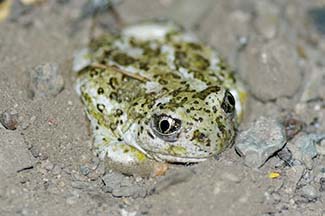Amphibians

At least five species of frogs and toads eke out livings at lower elevations in Owens Valley. Several more species of amphibians, including at least three salamander species, live on the east side of the Sierra Nevada or on the west side of the White and Inyo mountains that define the west and east sides of the valley, respectively. These include Pacific treefrogs (Pseudacris regilla), northern leopard frogs (Rana pipiens), bullfrogs (R. catesbeiana), Great Basin spadefoot toads (Spea intermontana), and western toads (Anaxyrus boreas) on the valley floor and at higher elevations; the Owens Valley web-toed salamander (Hydromantes platycephalus), the Kern Plateau slender salamander (Batrachoseps robustus), southern mountain yellow-legged frogs (R. muscosa), Sierra Nevada yellow-legged frogs (R. sierrae), and Yosemite toads (A. canorus) in the Sierra Nevada; and the Inyo Mountains slender salamander (B. campi) in the Inyo Mountains.
Non-native bullfrogs rule the valley floor with their indiscriminate appetites. Imported to the valley both for meat and for use as bait, they have been known to eat native frogs and toads as well as native fish. The northern leopard frog (which also may have been introduced to the valley) has given way to bullfrogs in areas where both species briefly overlapped, and it is now difficult to find leopard frogs on the valley floor. Given their dependence on moisture in the soil in which they bury themselves, Great Basin spadefoot toad populations have also likely plummeted since massive groundwater pumping lowered water tables below the rooting zone of vegetation (and therefore below toad burrowing levels) in many areas beginning in the early 1970s. Pacific treefrogs, however, which range from the valley floor to nearly 11,000 feet, can be found in marshy areas of the valley; stream and river areas; and occasionally even residential lawns.
High-altitude environments host a surprising number of amphibians, given a short growing season engendered by freezing temperatures. Rana muscosa (southern mountain yellow-legged frogs) and Rana sierrae (Sierra Nevada yellow-legged frogs), both endangered and both–until recently–traditionally considered a single species, have suffered massive population crashes in recent decades due to pesticide drift, non-native trout introduction, and the spread of a non-endemic fungus. (See MYL frog on the web to learn more about this.) Pacific treefrogs and Yosemite toads are faring somewhat better due to a shorter time to maturity and a more terrestrial lifestyle.
The status of east side salamander species such as the Owens Valley web-toed salamander remains less well-known due to salamander species’ nocturnal habits, shy nature, limited habitats, and a limited number of herpetologists working on the subject.
Ceal Klingler
